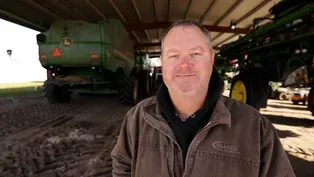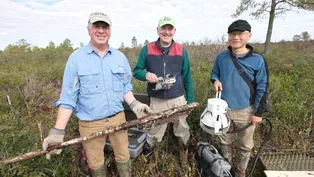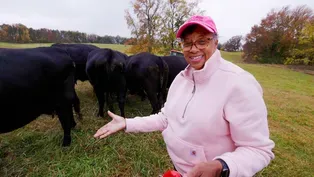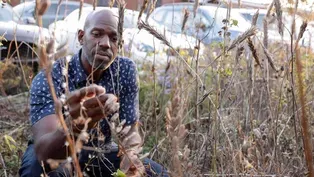
Planting Piedmont Grasslands Helps Fight Climate Change
Clip: Special | 8m 34sVideo has Closed Captions
Learn how planting native grassland plants mimics historical landscapes and stores carbon.
Grasslands are a surprising part of the North Carolina Piedmont’s ecological history. Learn how planting native grassland species in our yards and other open areas mimics historical landscapes while improving the soil and fighting our changing climate.
Problems with Closed Captions? Closed Captioning Feedback
Problems with Closed Captions? Closed Captioning Feedback
State of Change is a local public television program presented by PBS NC
State of Change is part of the Pulitzer Center’s Connected Coastlines reporting initiative. For more information, go to https://pulitzercenter.org/connected-coastlines.

Planting Piedmont Grasslands Helps Fight Climate Change
Clip: Special | 8m 34sVideo has Closed Captions
Grasslands are a surprising part of the North Carolina Piedmont’s ecological history. Learn how planting native grassland species in our yards and other open areas mimics historical landscapes while improving the soil and fighting our changing climate.
Problems with Closed Captions? Closed Captioning Feedback
How to Watch State of Change
State of Change is available to stream on pbs.org and the free PBS App, available on iPhone, Apple TV, Android TV, Android smartphones, Amazon Fire TV, Amazon Fire Tablet, Roku, Samsung Smart TV, and Vizio.
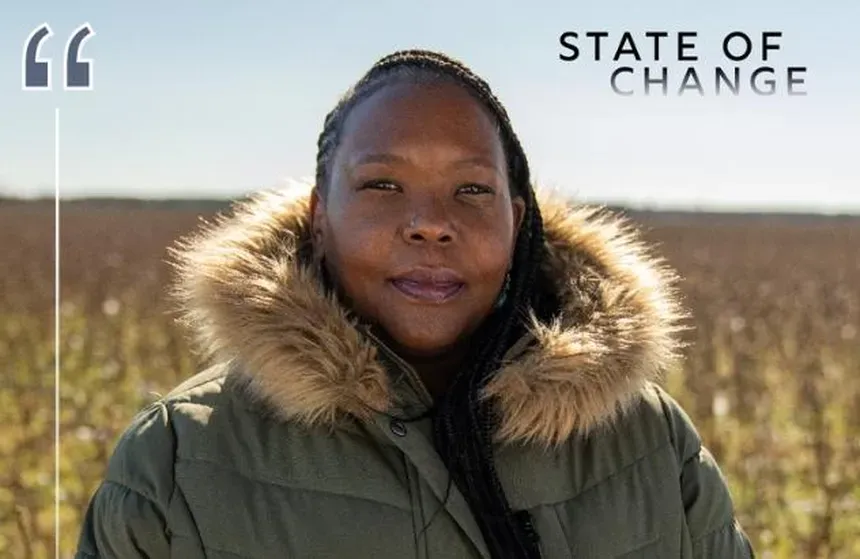
Explore More from State of Change
Hear from North Carolinians about climate change effects & innovative solutions across the state.[dreamy music] - The grasslands are a fundamental part of our landscape.
People are just starting to think about the value of grasses on their own.
These amazing plants that are indigenous to the Piedmont, very abundant, and very easy to plant.
We think that grasslands are about a third of the global carbon sink.
If you just think about all of our roadways, and backyards, and empty lots that could be turned into grasslands, and could sequester carbon, and foster biodiversity, filter storm water, [dreamy music continues] that's an incredible potential.
[dreamy music continues] There are records that we can read, dating back to the 1500s about grasslands.
Anyone that came here that was a European would write about waiting through the Savannahs.
- And a lot of that had to do with how indigenous people had been managing the land for thousands and thousands, and thousands and thousands of years.
- The early explorers, they found these grand open areas and the first explorer to this area, John Lawson, he could almost always smell smoke 'cause of the American Indians burning here.
- That's one of the things that made it so easy for Europeans to take over, is that it was already cleared, people weren't clearing as many trees as we imagined.
This was already a cultivated place.
Especially here in the Southeast and in North Carolina, grasslands have this very, very, very strong connection with human beings.
- The plants that make up the Piedmont Prairie the Piedmont Savannah, are what are called heliophilic, so their sun loving, and once they start to get shaded out, they decline.
- [Justin] And so one of the places we find some of these plants that have mostly vanished from other parts of the landscape, is in power line easements, and along roadsides.
We find these plants that look like they quote unquote, belong in the Midwest.
We find the big prairie grasses, we find the asters, we find the echinaceas, the coneflowers, we find them in these places because they are the right kinds of conditions.
- [Johnny] We are standing at the highest point in the Pennies Man Nature Preserve.
The plants that grow in so many of these sites grow in very poor soil conditions.
When the summertime, when it dries out, it's like concrete, but in the winter when it's wet, it's gummy.
That's why they have deep roots because they can spread out and grab what's out there.
- They could be up to 10 feet deep.
They have a whole relationship a whole ecosystem of microbes.
There are studies that show that the chemicals that come from grassland roots actually stay in the soil up to centuries.
And so they're working to sequester carbon for centuries.
- One of the important things to remember about plants that they cannot move, and so that fact changes everything about how they have to behave, and how they have to be set up to take all the different things that they will be surrounded by.
- [Tara] Native plants have a relationship to this place for thousands of years.
- Plants that are from here are able to cope with all of the different dynamics that are gonna happen in the place.
The times it will get the driest, the times it will get the wettest, the times it will get the coldest, the time it will get the hottest.
Plants have to prepare for the extreme events.
- There are a lot of climate models out there and still it's uncertain what's going to happen as climate changes.
Some of the models show that the Piedmont will become hotter and drier.
Well, that's okay for these Piedmont Savannah species because that's what they're adapted to.
They have seen so many different climates throughout their, let's say, genetic memory.
So we're hoping that the Piedmont is a place where there's a tremendous amount of resilience among the native plants here.
[pensive synth music] - One thing about prairie plants is that they thrive in degraded landscapes; and so if we think about all of our landscapes now as we're developed, so many of them are quote degraded, and people just sort of give up on 'em and think, "Maybe I'm not gonna plant anything," when actually they're the perfect landscapes, the perfect situation for prairie plants like this.
- So this is the Chatham Mills pollinator garden as stewarded and designed by Debbie Roos who is an extension agent here in Chatham County.
And as you can see, these are parking lot medians, right?
These are areas that would've been planted in great myrtles, and monkey grass, and some other things.
Look at what happened, what can happen, with just a little bit of attention, some knowledge, some know-how, like now this place is a haven for all these plants, for butterflies, and for bees, and all kinds of things.
And it changes the feel of where we are, right?
This feels like North Carolina in the way that like a strip mile parking lot would never.
[dreamy synth music] - When we're thinking about native plants in this area we have to think about grassland plants, not just woodland plants.
And as a result, we need to think about what that means about a garden.
A lot of our historical gardens are based on a dominant English idea of a formal garden with a yard, and very controlled plantings.
That's not necessarily made out of the plants that are native to this region, and that would thrive the most in this region.
So that means that we should be thinking about planting a different way.
[laughs] It's like a troll, it's a little troll.
- All right, you ready?
- Yeah.
- We are here in Carrboro, North Carolina, and we are here at the Toney and Nellie Strayhorn house.
This house has been here in my family for seven generations.
It was built in 1879 by brick masons, my family were brick masons, and they also were farmers, and they tended this land.
- I'm Landon's cousin.
We're working on plants together, thinking about ways that we can steward the land in this area for another nine generations.
- My great-grandmother was basically the last person to actually garden in this area, and I felt like it was a need to kind of restore that project.
I know some flowers, maybe a cardinal plant, but it was a lot of... She had a lot of diversity.
[gentle music] [plastic snapping] - When you're growing these kinds of grassland gardens, phase one doesn't need mulch.
We're just gonna keep the grass so to like out-compete the weeds, and the whole goal is eventually, our native grasses are gonna out-compete these grasses.
[gentle music continues] The best time is to plant them when they're sleeping, and so they're little like this.
And then use all of that energy when they start to grow to like put down their roots and like settle into their new home.
It's kind of like the plants are the soil amendment.
You don't need this extra mulch, you don't need this extra compost, it's really the plants.
[soft guitar music] - So one of the things we don't necessarily think about when we think about grasslands, is its ability to really help with our sort of climate crisis, right?
Plants like these tall, long-lived grasses, like big bluestem, or Indian grass, what we don't often understand is those plants can live for hundreds of years.
And so, over the course of that time they are taking all of this atmospheric carbon and taking it from the air and putting it underground, whereas long as we don't plow it up, will stay there.
- [Tara] 90% of grasslands' carbon sinks are below ground, which is really incredibly stable.
- [Justin] It is sequestering so much carbon and sequestering it in a way that trees can't, so grasslands play a huge role in keeping carbon in the soil.
- Restoring degraded landscapes could sequester 37% of the carbon that we need to keep temperature rise under 3.6 degrees.
To me, that's really powerful, because it's sort of like a low hanging fruit, like we need to create all these new technologies and switch the grid, and there's all these things we need to do.
But like, why would we not just be like planting backyard gardens and restoring landscapes, especially when they're low maintenance plants like this that were such an integral part of the landscape, and look pretty.
[inspiring music] So our goal is to get people to think about the past, as it informs the future, and create sustainable futures.
- It's an easy solution.
We're not trying to, you know, build some machines that are gonna live and spin around in the ocean, right?
This is already here.
[chuckling] You can drive on like any highway almost and see this same like starry pattern which is not true in other places, this looks like here.
- There's nothing more North Carolina than this.
[Justin chuckles] [gentle organ music]
Fighting Saltwater Intrusion in the Blacklands
Video has Closed Captions
Clip: Special | 9m 2s | Productive farmland in NC’s Tidewater region needs protection from rising sea levels. (9m 2s)
The Potential of Pocosin Peatlands’ Carbon Storage
Video has Closed Captions
Clip: Special | 8m 25s | Trek into the coastal peatlands and learn how these unique landscapes store carbon. (8m 25s)
Thinking Outside the Box with No-Till Farming
Video has Closed Captions
Clip: Special | 8m 22s | Farmers and researchers in Reidsville see the positive impacts of no-till agriculture. (8m 22s)
Video has Closed Captions
Preview: Special | 59s | North Carolinians are using natural solutions to respond to our changing climate. (59s)
Providing Support for PBS.org
Learn Moreabout PBS online sponsorshipSupport for PBS provided by:
State of Change is a local public television program presented by PBS NC
State of Change is part of the Pulitzer Center’s Connected Coastlines reporting initiative. For more information, go to https://pulitzercenter.org/connected-coastlines.
